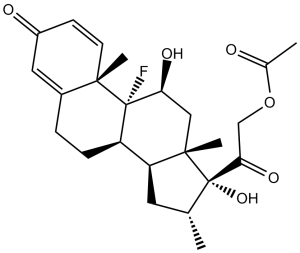This product is for research use only, not for human use. We do not sell to patients.

| Size | Price | Stock |
|---|---|---|
| 10g | $200 | Check With Us |
| 100g | $1090 | Check With Us |
| 200g | $1635 | Check With Us |
Cat #: V1838 CAS #: 1177-87-3 Purity ≥ 98%
Description: Dexamethasone Acetate (also known as NSC 39471) is the 21-acetoxy (ester) form of Dexamethasone, it is a potent synthetic glucocorticoid class of steroid drugs, and an interleukin receptor modulator with anti-inflammatory and immunosuppressive activities.
Publications Citing InvivoChem Products
Product Promise

- Physicochemical and Storage Information
- Protocol
- Related Biological Data
- Stock Solution Preparation
- Quality Control Documentation
| Molecular Weight (MW) | 434.5 |
|---|---|
| Molecular Formula | C24H31FO6 |
| CAS No. | 1177-87-3 |
| Storage | -20℃ for 3 years in powder formr |
| -80℃ for 2 years in solvent | |
| Solubility In Vitro | DMSO: 87 mg/mL (200.2 mM)r |
| Water: <1 mg/mLr | |
| Ethanol: 20 mg/mL (46.0 mM) | |
| SMILES Code | O=C1C=C[C@@]2(C)C(CC[C@@H]3[C@]2(F)[C@@H](O)C[C@@]4(C)[C@H]3C[C@@H](C)[C@]4(O)C(COC(C)=O)=O)=C1 |
| Synonyms | NSC 39471; NSC39471; NSC-39471; Dexamethasone acetate; Decadronal; Panasone; Dexamethasone 17-acetate |
| Protocol | In Vitro | protein-1, nuclear factor-AT, and nuclear factor-kB, leading to the activation and repression of key genes involved in the inflammatory response. |
|---|---|---|
| In Vivo | It has previously been reported that treatment with Dexamethasone (Hexadecadrol) at a dose of 2×5 mg/kg efficiently inhibits lipopolysaccharide (LPS)-induced inflammation. In our experimental system, treatment with a single dose of Dexamethasone 10 mg/kg (i.p.) significantly decreases recruitment of granulocytes as well as spontaneous production of oxygen radicals compared with animals expose to LPS and injected with solvent alone (saline). The effects are statistically significant when administered both 1 h before and 1 h after inhalation of LPS. The number of granulocytes in BALF decreased to levels comparable to healthy animals (given an aerosol of water). |
| Solvent volume to be added | Mass (the weight of a compound) | |||
|---|---|---|---|---|
| Mother liquor concentration | 1mg | 5mg | 10mg | 20mg |
| 1mM | 2.3015 mL | 11.5075 mL | 23.0150 mL | 46.0299 mL |
| 5mM | 0.4603 mL | 2.3015 mL | 4.6030 mL | 9.2060 mL |
| 10mM | 0.2301 mL | 1.1507 mL | 2.3015 mL | 4.6030 mL |
| 20mM | 0.1151 mL | 0.5754 mL | 1.1507 mL | 2.3015 mL |
This equation is commonly abbreviated as: C1 V1 = C2 V2
- (1) Please be sure that the solution is clear before the addition of next solvent. Dissolution methods like vortex, ultrasound or warming and heat may be used to aid dissolving.
- (2) Be sure to add the solvent(s) in order.




































